Youth
Society

In Communist propaganda, youth was abundantly developed as a topic, along with things like patriotism, heroism, folklore and enthusiasm for work. The primary reason youth occupied such a prominent place is because Communism saw itself as the future of the world, and therefore as a sort of universal youth. It also considered that age group as the future of the Socialist people. Young people therefore represented high stakes in the Communist project of forging the “new Socialist man”: through proper education, one could evolve from the “Me” of bourgeois individualism to the “We” of Socialist society. In Russia, in the aftermath of the October Revolution, Lenin had immediately seen schooling as the instrument of the Communist transformation of society. His goal was to construct a “Communist ethos,” which would be embodied in homo sovieticus, who would naturally spring from the proletariat. This new person represented the first step towards a new society that had been elaborated in theory, but which had yet to be built. The goal of the Soviet school system, which was reprised in all the Eastern-bloc countries, was to forge a “complete” individual by combining intellectual, athletic and manual education. In addition to school itself, which played a large role, there were youth organizations to handle leisure activities. All in all, while school did play an important role in allowing for social mobility and ensuring the replacement of Socialist elites, it nevertheless failed globally in its goal of ideological mentorship. Even the generations born under Socialism remained, for their vast majority, impermeable to Communist regimes’ ideological goals. Youth continued to look towards the West, influenced by Western music and clothes, and turning away from Communist values and morals. Instead they found refuge in smaller “niches,” like family or groups of friends, where individuality and originality were cultivated.
Archive
Caricature from the satirical magazine Krokodil: Youth
While the official image of Soviet youth was one of a homogenous, unified group based on the homo sovieticus model, the reality was quite different.
country: Soviet Union / year:
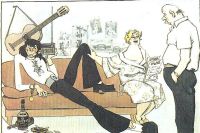
While the official image of Soviet youth was one of a homogenous, unified group based on the homo sovieticus model, the reality was quite different. In the 1970s, officially led youth structures, like the Komsomol, were rejected by a small but determined minority who used whatever methods they could to proclaim their opposition to the regime, including hanging out (“kajfovat” in Russian slang, i.e. being lazy) at home or at tusovkas, informal meetings or social events.
International peace meetings for young people
Youth, peace and friendship between peoples were among the key themes Communist propaganda celebrated at official gatherings, meetings, festivities and athletic competitions.
country: Soviet Union / year:
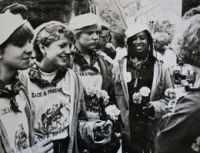
Youth, peace and friendship between peoples were among the key themes Communist propaganda celebrated at official gatherings, meetings, festivities and athletic competitions. From a Communist point of view, it was a matter of focusing on certain moral practices, like solidarity, and developing youth participation, particularly in well-organized associations. In these international gatherings of young people we can see how Communist regimes exploited these values by incorporating them into a universal discourse (“The language of peace and friendship is comprehensible by everyone”).
Brejnev-era poster celebrating the values of student construction brigades
"Here we live, work and study"
country: Soviet Union / year:
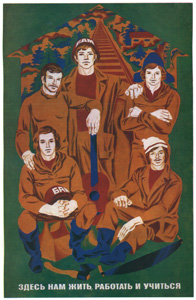
"Here we live, work and study" One of the values Communism intended to instill in youth was a love of work. Of course there was an economic goal to this, but also an ideological one: it was a matter of developing young people’s Socialist consciences by providing them with a stake in the construction of the peasants’ and workers’ state. The gigantic Baikal Amur Mainline project was one such occasion for mobilizing youth. The BAM was a more than 4,000-km long railway track crossing Siberia towards the Far East, connecting Lake Baikal with the Amur River. Construction of this track – begun in the 1930s and unfinished to this day – was carried out for the most part between 1972 and 1984 at huge financial and human costs. These were justified by the prospect of exploiting Siberian resources. The Komsomol were mobilized to kindle young people’s enthusiasm for participating in the project. In order to recruit volunteers, they emphasized the values of work, collective organization and education – all key Socialist ideals.
Excerpts from the “Pioneer’s Book”: tell-tale signs of the Pioneers organization
Modeled on the scouting movement, the Pioneers supervised young Soviets from age 10 to age 14, readying them for entry into the Komsomol.
country: Soviet Union / year:
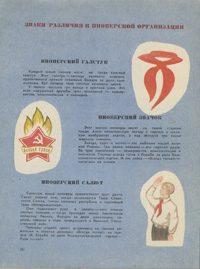
Modeled on the scouting movement, the Pioneers supervised young Soviets from age 10 to age 14, readying them for entry into the Komsomol. The images evoke the Marxist-Leninist ideal of a complete education. They illustrate the different moments in a Pioneer’s day, red scarf tied around his or her neck, as he or she goes from intellectual exercise to physical exercise, from moments of leisure to moments of contribution to collective efforts. Beyond the ideological education it provided, the Pioneer movement, like all other Communist-country youth organizations, aimed at attracting young people – the better to mobilize them in favor of the regime. The ultimate goal was to obtain the loyalty of future citizens by framing their mindset while they were still young.
Excerpts from the “Pioneer’s Book”: Organizing a Pioneer’s day I
Modeled on the scouting movement, the Pioneers supervised young Soviets from age 10 to age 14, readying them for entry into the Komsomol.
country: Soviet Union / year:
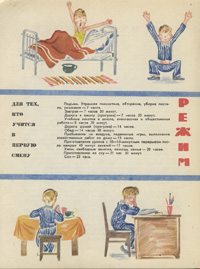
Modeled on the scouting movement, the Pioneers supervised young Soviets from age 10 to age 14, readying them for entry into the Komsomol. The images evoke the Marxist-Leninist ideal of a complete education. They illustrate the different moments in a Pioneer’s day, red scarf tied around his or her neck, as he or she goes from intellectual exercise to physical exercise, from moments of leisure to moments of contribution to collective efforts. Beyond the ideological education it provided, the Pioneer movement, like all other Communist-country youth organizations, aimed at attracting young people – the better to mobilize them in favor of the regime. The ultimate goal was to obtain the loyalty of future citizens by framing their mindset while they were still young.
Excerpts from the “Pioneer’s Book”: Organizing a Pioneer’s day II
Modeled on the scouting movement, the Pioneers supervised young Soviets from age 10 to age 14, readying them for entry into the Komsomol.
country: Soviet Union / year:
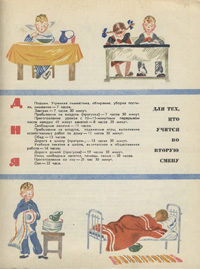
Modeled on the scouting movement, the Pioneers supervised young Soviets from age 10 to age 14, readying them for entry into the Komsomol. The images evoke the Marxist-Leninist ideal of a complete education. They illustrate the different moments in a Pioneer’s day, red scarf tied around his or her neck, as he or she goes from intellectual exercise to physical exercise, from moments of leisure to moments of contribution to collective efforts. Beyond the ideological education it provided, the Pioneer movement, like all other Communist-country youth organizations, aimed at attracting young people – the better to mobilize them in favor of the regime. The ultimate goal was to obtain the loyalty of future citizens by framing their mindset while they were still young.
Report on Romanian playgrounds in 1968
Images of playgrounds supervised by benevolent educators suggest the high value Communist ideology placed on education of the very young.
country: People’s Republic of Romania / year:
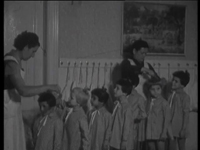
Images of playgrounds supervised by benevolent educators suggest the high value Communist ideology placed on education of the very young. Hygiene, games of chess, writing exercises, artistic activities – especially music – all these mirrored the Socialist education model, which strove to be as complete as possible. Nevertheless, one is struck by the gender bias of the toys offered to the younger children: dolls for girls, planes and other machinery for boys. MUTE
Admission ceremony to the Komsomol
Considered as the Soviet people’s future, youths were recruited at an early age
country: Soviet Union / year:
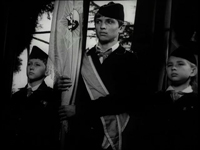
Considered as the Soviet people’s future, youths were recruited at an early age. The Pioneers, aged 10 to 14, preceded the Communist Youth League (Komsomol), which had been created in 1918. Endowed with a Central Committee under the direct control of the Communist Party, the Komsomol regrouped the vast majority of young Soviets between the ages of 14 and 28 – some 40 million members at its peak in the 1980s. Admission to the Komsomol, extolled here by radiant smiling faces, marked a teenager’s entry into Soviet society. It was also accompanied by an ostensibly military ritual. Active members had privileges and were more likely to get promoted. It is thanks to his role in the Karelia Komsomol, for example, that Yuri Andropov got the job of General Secretary of the CPSU. During perestroika, members of the Komsomol were encouraged to invest in the private sector and had advantages when they did so.